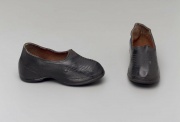Difference between revisions of "Rubber (synthetic)"
(username removed) |
(username removed) |
||
| Line 2: | Line 2: | ||
== Description == | == Description == | ||
| − | Any man-made [http://cameo.mfa.org/materials/fullrecord.asp?name=elastomer elastomer]. The development of synthetic rubbers was stimulated when rubber imports ceased in 1941 due to Japanese occupation in southeast Asia. Within 3 years, US manufacturers had developed over nine types of elastomers. Most age better than [http://cameo.mfa.org/materials/fullrecord.asp?name=rubber | + | Any man-made [http://cameo.mfa.org/materials/fullrecord.asp?name=elastomer elastomer]. The development of synthetic rubbers was stimulated when rubber imports ceased in 1941 due to Japanese occupation in southeast Asia. Within 3 years, US manufacturers had developed over nine types of elastomers. Most age better than [http://cameo.mfa.org/materials/fullrecord.asp?name=rubber%2C%20natural natural rubber] but are still susceptible to degradation by [http://cameo.mfa.org/materials/fullrecord.asp?name=ozone ozone] and [http://cameo.mfa.org/materials/fullrecord.asp?name=ultraviolet%20radiation ultraviolet light]. All rubbers must be chemically vulcanized to form an stable product. The unsaturated materials are [http://cameo.mfa.org/materials/fullrecord.asp?name=vulcanization vulcanized] with [http://cameo.mfa.org/materials/fullrecord.asp?name=sulfur sulfur] while others are vulcanized with [http://cameo.mfa.org/materials/fullrecord.asp?name=hydrogen%20peroxide peroxide], metallic oxide, or [http://cameo.mfa.org/materials/fullrecord.asp?name=diisocyanate diisocyanates]. Examples of synthetic rubbers are: [http://cameo.mfa.org/materials/fullrecord.asp?name=butadiene butadiene], [http://cameo.mfa.org/materials/fullrecord.asp?name=styrene styrene]; [http://cameo.mfa.org/materials/fullrecord.asp?name=Buna Buna], [http://cameo.mfa.org/materials/fullrecord.asp?name=nitrile%20rubber nitrile rubber], SBR ([http://cameo.mfa.org/materials/fullrecord.asp?name=styrene-butadiene%20rubber styrene-butadiene rubber]), ABS ([http://cameo.mfa.org/materials/fullrecord.asp?name=acrylonitrile%20butadiene%20styrene%20resin acrylonitrile butadiene styrene]), EPR ([http://cameo.mfa.org/materials/fullrecord.asp?name=ethylene%20propylene%20rubber ethylene propylene rubber]), EPDM ([http://cameo.mfa.org/materials/fullrecord.asp?name=ethylene%20propylene%20terpolymer ethylene propylene diene]), [http://cameo.mfa.org/materials/fullrecord.asp?name=butyl%20rubber butyl rubber] (isoprene), [http://cameo.mfa.org/materials/fullrecord.asp?name=neoprene neoprene] (polychloroprene), [http://cameo.mfa.org/materials/fullrecord.asp?name=polysulfide polysulfide], [http://cameo.mfa.org/materials/fullrecord.asp?name=silicone silicone] (polysiloxane), [http://cameo.mfa.org/materials/fullrecord.asp?name=epichlorohydrin epichlorohydrin], [http://cameo.mfa.org/materials/fullrecord.asp?name=polyurethane polyurethane]. |
[[File:2006.551-SC179216.jpg|thumb|'''MFA Acc. #:''' 2006.551]] | [[File:2006.551-SC179216.jpg|thumb|'''MFA Acc. #:''' 2006.551]] | ||
== Synonyms and Related Terms == | == Synonyms and Related Terms == | ||
| − | synthetic rubber; caucho | + | synthetic rubber; caucho sintético (Esp.); caoutchouc synthétique (Fr.); gomma sintetica (It.); borracha sintética (Port.) |
Examples: isoprene; butadiene; styrene; Buna; nitrile; SBR; ABS; EPR; butyl; neoprene; polysulfide; | Examples: isoprene; butadiene; styrene; Buna; nitrile; SBR; ABS; EPR; butyl; neoprene; polysulfide; | ||
| Line 13: | Line 13: | ||
== Authority == | == Authority == | ||
| − | * | + | * Theodore J. Reinhart, 'Glossary of Terms', ''Engineered Plastics'', ASM International, 1988 |
| − | * | + | * M.Kaufman, ''The First Century of Plastics'', The Plastics and Rubber Institute, London, 1963 |
| − | * | + | * Pam Hatchfield, ''Pollutants in the Museum Environment'', Archetype Press, London, 2002 |
[[Category:Materials database]] | [[Category:Materials database]] | ||
Revision as of 07:54, 24 July 2013
Description
Any man-made elastomer. The development of synthetic rubbers was stimulated when rubber imports ceased in 1941 due to Japanese occupation in southeast Asia. Within 3 years, US manufacturers had developed over nine types of elastomers. Most age better than natural rubber but are still susceptible to degradation by ozone and ultraviolet light. All rubbers must be chemically vulcanized to form an stable product. The unsaturated materials are vulcanized with sulfur while others are vulcanized with peroxide, metallic oxide, or diisocyanates. Examples of synthetic rubbers are: butadiene, styrene; Buna, nitrile rubber, SBR (styrene-butadiene rubber), ABS (acrylonitrile butadiene styrene), EPR (ethylene propylene rubber), EPDM (ethylene propylene diene), butyl rubber (isoprene), neoprene (polychloroprene), polysulfide, silicone (polysiloxane), epichlorohydrin, polyurethane.
Synonyms and Related Terms
synthetic rubber; caucho sintético (Esp.); caoutchouc synthétique (Fr.); gomma sintetica (It.); borracha sintética (Port.)
Examples: isoprene; butadiene; styrene; Buna; nitrile; SBR; ABS; EPR; butyl; neoprene; polysulfide;
Authority
- Theodore J. Reinhart, 'Glossary of Terms', Engineered Plastics, ASM International, 1988
- M.Kaufman, The First Century of Plastics, The Plastics and Rubber Institute, London, 1963
- Pam Hatchfield, Pollutants in the Museum Environment, Archetype Press, London, 2002

